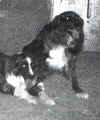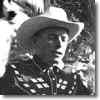

Workn Aussies
a site dedicated to Wood's Jay and all the exceptional dogs that have contributed to Chevreherd Australian Shepherds
Fletcher Wood
Virtually all Aussies have a common ancestor in the dog named Wood's Jay. Three early female descendants of Wood's Jay (with line-breeding on Harper's Old Smokey) helped to establish the Flintridge kennel, behind almost all modern show-type Aussies. In addition, several working-type Aussie breeders continued to use the descendents of Wood's Jay
According to ASCA's 1957-1977 Yearbook, Fletcher Wood acquired
Jay in 1949 from Jay Sisler (of dog trick act and Disney movie fame). Mr. Wood
was ringmaster at the National Western Livestock Show at the Jefferson County
Fairgrounds near Denver, Colorado and numbered among the many who admired Sisler's
Shorty in the rodeo act of that day. Wood's Jay (Shorty x Trixie) was a
large dark merle dog with little white who was quite a utility worker both in
the stock arena and on the cattle range
Mr. Wood practiced close line-/inbreeding to Wood's Jay and established a
"type" still able to be recognized as descending from his dogs
There was some variation in body type and ear set according to
how breeders continued on with dogs acquired from Mr. Wood, but basic breeding
goals continued to be for a tough cattle-working dog with solid, dark body
colors and minimal trim (white or copper/tan). In essence, Wood's dogs were
developed from ornery old ranch dogs who only liked one person and liked to use
their mouths a lot whether at work or play; they were very independent, very dog
aggressive, very smart, very devoted, and too much dog for the average person.
Jay Sisler

 A
special note: Jay Sisler is a name known by almost every person who has been
around Aussies for very long. He was inducted into the Pro
Rodeo Hall of Fame in August 2002. Jay's line of dogs started with a red dog,
Keno who was acquired around 1945. Jay's brother, Gene acquired Blue Starr (or
"Old Blue") at a local Idaho livestock auction in 1947.From these two
came Stub and Shorty. Per ASCA's Yearbook, the Sisler-trained dog act was quite
incredible. His Aussies being so eager to please would jump rope, stand on their
heads, balance on bars, climb ladders and more. This constant exposure of these
dogs to rodeo fans throughout the country led to great interest in the breed. So
began the spread of the Sisler line (he called them simply "blue
dogs") to nearly everywhere a good cow dog was required. A greater
concentration of this line, of course, was seen in the Northwestern US and into
Canada. Sisler was breaking horses for a living when he started in his rodeo
career with help from his two cattle-working dogs, Stub and Shorty. The
year was 1949 and Sisler was paid $10. Sisler went on to perform in many of the
largest stadiums in the US and Canada, including Madison Square Gardens, San
Francisco's Cow Palace, and the Calgary Stampede during the 1950's and 1960's
They also appeared on the Ed Sullivan Show and toured with Roy Rogers. Sisler
dogs played the lead in several movies, including two Walt Disney productions, Cow
Dog and Stub: Best Cow Dog in the West. Sisler died on July 8, 1995
in a ranching accident. He was 69.
A
special note: Jay Sisler is a name known by almost every person who has been
around Aussies for very long. He was inducted into the Pro
Rodeo Hall of Fame in August 2002. Jay's line of dogs started with a red dog,
Keno who was acquired around 1945. Jay's brother, Gene acquired Blue Starr (or
"Old Blue") at a local Idaho livestock auction in 1947.From these two
came Stub and Shorty. Per ASCA's Yearbook, the Sisler-trained dog act was quite
incredible. His Aussies being so eager to please would jump rope, stand on their
heads, balance on bars, climb ladders and more. This constant exposure of these
dogs to rodeo fans throughout the country led to great interest in the breed. So
began the spread of the Sisler line (he called them simply "blue
dogs") to nearly everywhere a good cow dog was required. A greater
concentration of this line, of course, was seen in the Northwestern US and into
Canada. Sisler was breaking horses for a living when he started in his rodeo
career with help from his two cattle-working dogs, Stub and Shorty. The
year was 1949 and Sisler was paid $10. Sisler went on to perform in many of the
largest stadiums in the US and Canada, including Madison Square Gardens, San
Francisco's Cow Palace, and the Calgary Stampede during the 1950's and 1960's
They also appeared on the Ed Sullivan Show and toured with Roy Rogers. Sisler
dogs played the lead in several movies, including two Walt Disney productions, Cow
Dog and Stub: Best Cow Dog in the West. Sisler died on July 8, 1995
in a ranching accident. He was 69.
The Basque Connection
Chevreherd has studied what has been written about the Basque people who came to America. There is not very much to read as the Basque are a unique breed of humans who were rather isolated in the Pyrenees Mountains bordering France/Spain and had no real written language and a verbal language unrelated to any other. Circumstances in the 19th century drove them to seek new lives in America and Australia. In Australia they cut sugar cane and in America they became shepherds of flocks. So whether many of them brought their dogs with them, versus picked up their dogs from the ranchers who were raising the sheep remains the mystery. Early Aussie fanciers consistently tell of the blue dogs that the Basque shepherds they met were using. If the blue dogs arrived by ship from Spain via last port Australia, the shepherds accompanying these flocks were likely Basque; this is my current theory. Certainly the Aussie is a type of dog that fit the needs of the American West and we continue to appreciate the part these dogs have played in our history. Overall, I think the Aussie type of dog developed in the same way the Appaloosa horse did in North America; chosen for a type and developed into a breed.
Australian?
Australian dog breed histories consistently document that they claim British Isle/European beginnings. In North America's eastern part of the country it is documented that these dogs were of British/European origin. Undoubtedly these dogs also contributed to today's Aussie. The dogs followed the movement of the sheep and farmers/ranchers around the world and across the country. I think of our Aussies as a true dog "type" that has been around from the beginnings of time. The melting pot that is the United States has a great breed of dog in the Australian Shepherd.
Chevreherd loves the Australian Shepherd and appreciates the opportunity to share all the historical information we've stumbled across through the years. Explore the pages below to find information about some of the dogs behind Chevreherd.
The photo albums are divided up based on the article I wrote "Figuring Ancestry Percentages" published in the 1997 edition of Hoflin's Australian Shepherd Annual .
| Aussie History Article | Photo Album--Other's Influence | |
| Figuring Percentages | Photo Album--Vest Influence | |
| Links | Photo Album--Wood's Influence | |
| Photo Album--Chevreherd | More about Bob Vest |
More photos added to the Wood's and the Other's pages 06/20/2003. Also updates on the Bob Vest pages.
| Copyright © 1982 [CHEVREHERD Australian Shepherds]. All rights reserved. Page last edited: 06/20/03 |